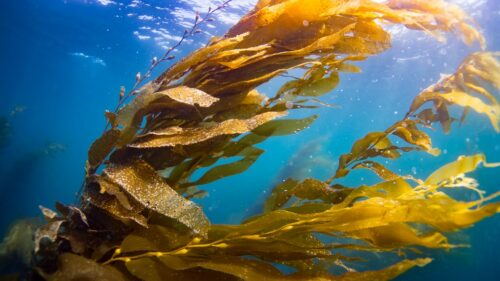Image courtesy of Flickr.
The environmental threats posed by fossil fuels, such as their rapid depletion and the climate change threats posed by their emissions, have made the need for renewable energy sources more and more apparent. Biofuel, fuel derived from plants, could supplement our current energy paradigm and could one day replace fossil fuels. However, biofuels from certain feedstocks, such as corn-based ethanol, pose significant disadvantages: they compete for land and fresh water, the pesticides and fertilizers used to grow them pollute surrounding waterways, and they may be carbon-intensive.
The ocean’s giant kelp, Macrocystis pyrifera, circumvents these issues. Not only does it have the potential to be a carbon-neutral energy source, but it does not require land nor disrupt habitats. As a bonus, kelp fits into the existing energy infrastructure. However, the limited nutrients in the photic zone (near the ocean’s surface) limits the growth of this seaweed, thus hampering the large-scale development of M. pyrifera as a biofuel. To optimize the growth process, a team of researchers, including USC’s Diane Young Kim, recently developed a solution that allows the seaweed both sufficient sunlight and nutrients. They deemed their novel technology the “kelp-elevator.”
The scientists hypothesized that, using this kelp-elevator, they could maximize growth with a depth-cycling approach: raising and lowering the kelp to provide it with the proper nutrients depending on the time of day. At 7:00 PM, the elevator would lower the kelp to eighty meters deep, where the water is rich in the necessary nitrates; at 5:00 AM, the kelp would be raised back to nine meters, allowing it a full day of sunlight.
The researchers, in addition to growth, also took note of the plant’s morphology and chemical composition after undergoing this process for ninety days. Compared to a control group, the depth-cycled kelp produced up to four times as much biomass. Additionally, its pneumatocysts, seaweed blade-attached bladders that are usually air-filled) were surprisingly fluid-filled, impacting buoyancy. This morphological difference may cause the seaweed fronds to shade each other, affecting the engineering parameters in furthering this research.
The depth-cycled kelp further showed distinct levels of δ15N and δ13C, stable nitrogen and carbon isotopes. This revealed that the kelp successfully assimilated nutrients from the deeper water. “While the nitrogen and protein content demonstrated that the depth-cycled kelp were not nutrient deficient, it was also important to show that the nitrogen the kelp acquired was from deep water,” Kim said. “If nutrients were acquired from the surface of the ocean, that defeats the purpose of depth-cycling,” The isotopic signature matched that of the deep ocean, confirming the source of the seaweed’s nutrition.
This research provides the first step towards utilizing giant kelp as a widespread biofuel. “The broader context is big… it holds great promise and potential to diversify the alternative energy portfolio,” Kim said. She also explained that kelp may fill a niche in the current energy landscape. Electric vehicles, for instance, are another part of the solution, but are not yet suitable for long distances; kelp-based biofuel could fill in here to fuel planes and long-range trucks.
Before considering the larger implications, however, the immediate steps to further this research lie in fine-tuning the procedure: changing the depth-cycling parameters, finding the sweet-spot of nitrate levels, and selectively breeding kelp for desirable traits. If seaweed meets its full potential, it offers a stepping stone on the pathway to eliminating fossil fuel usage.
Citations
Navarrete, I. A., Kim, D. Y., Wilcox, C., Reed, D. C., Ginsburg, D. W., Dutton, J. M., Heidelberg, J., Raut, Y., & Wilcox, B. H. (2021). Effects of depth-cycling on nutrient uptake and biomass production in the giant kelp Macrocystis pyrifera. Renewable and Sustainable Energy Reviews, 141, 110747. https://doi.org/10.1016/j.rser.2021.110747

